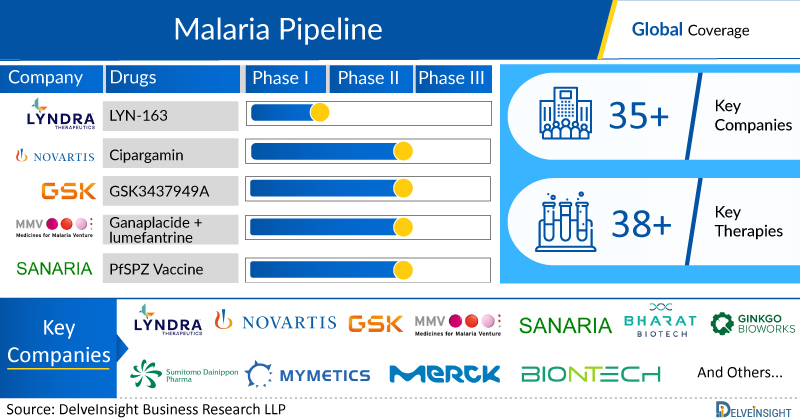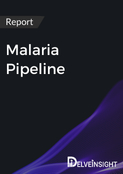malaria pipeline insight
DelveInsight’s, “Malaria - Pipeline Insight, 2025,” report provides comprehensive insights about 15+ companies and 20+ pipeline drugs in Malaria pipeline landscape. It covers the pipeline drug profiles, including clinical and nonclinical stage products. It also covers the therapeutics assessment by product type, stage, route of administration, and molecule type. It further highlights the inactive pipeline products in this space.
Geography Covered
- Global coverage
Malaria Understanding
Malaria: Overview
Malaria is a life-threatening disease caused by parasites that are transmitted to people through the bites of infected female Anopheles mosquitoes. It is preventable and curable. In 2019, there were an estimated 229 million cases of malaria worldwide. Malaria is caused by Plasmodium parasites. The parasites are spread to people through the bites of infected female Anopheles mosquitoes, called "malaria vectors." There are 5 parasite species that cause malaria in humans, and 2 of these species – P. falciparum and P. vivax – pose the greatest threat. Malaria is an acute febrile illness. In a non-immune individual, symptoms usually appear 10–15 days after the infective mosquito bite. The first symptoms – fever, headache, and chills – may be mild and difficult to recognize as malaria. If not treated within 24 hours, P. falciparum malaria can progress to severe illness, often leading to death. Early diagnosis and treatment of malaria reduces disease and prevents deaths. Antimalarial medicines can also be used to prevent malaria. For travellers, malaria can be prevented through chemoprophylaxis, which suppresses the blood stage of malaria infections, thereby preventing malaria disease. The most common antimalarial drugs include: Chloroquine phosphate, Chloroquine is the preferred treatment for any parasite that is sensitive to the drug.
"Malaria - Pipeline Insight, 2025" report by DelveInsight outlays comprehensive insights of present scenario and growth prospects across the indication. A detailed picture of the Malaria pipeline landscape is provided which includes the disease overview and Malaria treatment guidelines. The assessment part of the report embraces, in depth Malaria commercial assessment and clinical assessment of the pipeline products under development. In the report, detailed description of the drug is given which includes mechanism of action of the drug, clinical studies, NDA approvals (if any), and product development activities comprising the technology, Malaria collaborations, licensing, mergers and acquisition, funding, designations and other product related details.
Report Highlights
- The companies and academics are working to assess challenges and seek opportunities that could influence Malaria R&D. The therapies under development are focused on novel approaches to treat/improve Malaria.
- This segment of the Malaria report encloses its detailed analysis of various drugs in different stages of clinical development, including phase II, I, preclinical and Discovery. It also helps to understand clinical trial details, expressive pharmacological action, agreements and collaborations, and the latest news and press releases.

Malaria Recent Developments
- In March 2025, the U.S. Food and Drug Administration placed a clinical hold on BioNTech's early-to-mid stage trial of its experimental malaria vaccine, BNT165e. The trial aimed to evaluate the safety and efficacy of the RNA-based vaccine for preventing malaria caused by the P. falciparum parasite in healthy adults who had never had malaria. Following the announcement, BioNTech's U.S.-listed shares fell by 1.5%.
Malaria Drugs
Cipargamin: Novartis
Cipargamin is the first antimalarial drug candidate with a novel mechanism of action to achieve positive clinical proof-of-concept in over 20 years. Cipargamin, the first compound in the spiroindolone class of treatment, works through a novel mechanism of action that involves inhibition of a P-type cation-transporter ATPase4 (PfATP4), which regulates sodium concentration in the parasite. Because Cipargamin also appears to be effective against the sexual forms of the parasite, it could potentially help prevent disease transmission. Cipargamin was tested in adult patients with uncomplicated malaria and showed a median parasite clearance time of 12 hours, including in patients with resistant infections. Currently the product is in Phase II stage of development for the treatment of Malaria.
Further product details are provided in the report……..
Malaria: Therapeutic Assessment
This segment of the report provides insights about the Malaria drugs segregated based on following parameters that define the scope of the report, such as:
Major Players in Malaria
There are approx. 15+ key companies which are developing the therapies for Malaria. The companies which have their Malaria drug candidates in the most advanced stage, i.e. Phase I include Novartis.
Phases
DelveInsight’s report covers around 20+ products under different phases of clinical development like
- Late stage products (Phase III)
- Mid-stage products (Phase II)
- Early-stage product (Phase I) along with the details of
- Pre-clinical and Discovery stage candidates
- Discontinued & Inactive candidates
Route of Administration
Malaria pipeline report provides the therapeutic assessment of the pipeline drugs by the Route of Administration. Products have been categorized under various ROAs such as
- Intranasal
- Intrathecal
- Intravenous
- Oral
- Oral/Intravenous
- Parenteral
- Subcutaneous
- Subcutaneous/Intramuscular
- Transdermal
Molecule Type
Products have been categorized under various Molecule types such as
- Antisense oligonucleotide
- Gene therapy
- Hormones
- Neuropeptides
- Oligonucleotides
- Small Molecule
- Triglyceride
Product Type
Drugs have been categorized under various product types like Mono, Combination and Mono/Combination.
Malaria: Pipeline Development Activities
The report provides insights into different therapeutic candidates in phase III, II, I, preclinical and discovery stage. It also analyses Malaria therapeutic drugs key players involved in developing key drugs.
Pipeline Development Activities
The report covers the detailed information of collaborations, acquisition and merger, licensing along with a thorough therapeutic assessment of emerging Malaria drugs.
Malaria Report Insights
- Malaria Pipeline Analysis
- Therapeutic Assessment
- Unmet Needs
- Impact of Drugs
Malaria Report Assessment
- Pipeline Product Profiles
- Therapeutic Assessment
- Pipeline Assessment
- Inactive drugs assessment
- Unmet Needs
Key Questions
Current Scenario and Emerging Therapies:
- How many companies are developing Malaria drugs?
- How many Malaria drugs are developed by each company?
- How many emerging drugs are in mid-stage, and late-stage of development for Malaria?
- What are the key collaborations (Industry–Industry, Industry–Academia), Mergers and acquisitions, licensing activities related to the Malaria therapeutics?
- What are the recent trends, drug types and novel technologies developed to overcome the limitation of existing therapies?
- What are the clinical studies going on for Malaria and their status?
- What are the key designations that have been granted to the emerging drugs?
